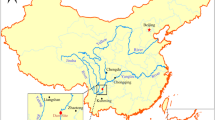Abstract
The 2008 Wenchuan earthquake is one of the major natural disasters in China and caused serious casualties, enormous property losses, and further earthquake-induced geo-hazard. Among them, Tangjiashan barrier dam is the most dangerous potential hazard formed by a large consequent bedding rock landslide to block the Tongkou River in Beichuan County. Based on accurately obtained data of geological structure and relevant permeability parameters of Tangjiashan barrier dam, using the three-dimensional visualization software named Visual Modflow, the seepage field of dam under four conditions of water levels (710, 720, 730 and 740 m) of the dammed lake were simulated. According to the results of simulated calculation, each soil layer’s seepage velocity and seepage gradient were calculated, and the analytical results show that the first and the second layers have the characteristics of coarse particles and high permeability, with the overall performance of a stable flow, presenting the characteristics of seepage and stable change of overall gradient, and it will not have turbulent conditions like low-permeability clay, inflexion of seepage gradient and the characteristics of piping between the two layers. The maximum seepage gradient in gravel soil of the first layer is more than allowed gradient in the transition between the first layer and the third layer, so it will cause sporadic or partial seepage destruction on downstream of barrier dam. And simulated results also show that gravel soil of the first layer will experience seepage failure when the water level of dammed lake is more than 726 m. With the uplift of water level, the dam-breaking mode of overall barrier dam is that gravel soil of the first layer will be eroded and washed away by the seepage failure and head erosion, also by the down-cutting caused by overflow. The blocks and gravels of the second layer will be gradually washed away and down-cut because the first layer is washed as well as the water velocity is increased, but overall breaking will not happen. The quasi-lamellar cataclastic rocks of the third layer will remain stable, and the depth of erosion and down-cutting is the top of the third layer.
Access this chapter
Tax calculation will be finalised at checkout
Purchases are for personal use only
Similar content being viewed by others
References
Ding F, He L, Zhang Q et al (2008) Application of visual Modflow numerical simulation for water environment in a plain reservoir. J Resour Water Eng 19(2):79–81
Fan X, Tang CX, van Westen CJ et al (2012) Simulating dam-breach flood scenarios of the Tangjiashan landslide dam induced by the Wenchuan Earthquake. Natural hazards and earth system sciences 12, 3031–3044
Feng L, Xiang Y, Pan K (2004) Discussion of visual modflow modeling applications. Xinjiang Geol 22(3):275–277
He B (1999) Application of processing MODFLOW software in the prevention and control of groundwater pollution. Water Resour Prot 57(3):16–18
Hu Y, Xie S, Jing M et al (2006) Visual Modflow and Its application problems in groundwater simulation. J Nanhua Univ 20(2):1–5
Hu X, Huang R, Shi Y et al (2009) Analysis on dam-breaking mode of Tang Jiashan barrier dam in Beichuan county. Chin J Rock Mech Eng 28(1):181–189
Lin Q, Lin P, Bai J et al (2011) A numerical study of dam-break flow and sediment transport from a quake lake. J Earthq Tsunami 5(5):401–428
Liu Y, Pan G (2009) Mine inflow prediction and numerical simulation on descending flow field of karst water based on visual Modflow. J Henan Polytech Univ 28(1):51–54
Tang C (2012) 2-D flash flood simulation of Tangjiashan landslide dam induced by the Wenchuan earthquake. Master thesis of the faculty of geo-information science and earth observation of the University of Twente, pp 20–34
TU L, Song H (2009) Numerical simulation of groundwater flow in the middle reaches of Heihe River based on visual Modflow. Investig Sci Technol 2:19–23
Wang M, Xu H (2008) Analysis on discharge effects on TangJiashan dam slope. Yangtze River 39(22):48–51
Wang G, Liu F, Fu X et al (2008) Simulation of dam breach development for emergency treatment of the Tangjiashan Quake Lake in China. Sci China Ser E: Technol Sci 51(Suppl. 2):82–94
Wu A, Lin S, Ma G et al (2008) Formation mechanism analysis on Tang Jiashan barrier dam by DDA software. Yangtze River 39(22):91–95
Xi Z, Chen S (2008) Dam- break possibilities and preliminary analysis on scouring form of Tang Jiashan barrier dam. Yangtze River 39(22):71–78
Yang Q, Lu W, MA H (2005) Groundwater simulation in west of Jilin Province by visual Modflow. Hydrogeol Eng Geol 32(3):67–69
Acknowledgments
The authors are grateful for funding from the National Natural Science Foundation Project (Grant No. 41372293), and from the National Natural Science Foundation Project-mutual fund of Yunnan Province (Grant No.U1033601).
Author information
Authors and Affiliations
Corresponding author
Editor information
Editors and Affiliations
Rights and permissions
Copyright information
© 2015 Springer International Publishing Switzerland
About this paper
Cite this paper
Hu, X.W., Luo, G., Lv, J.L., Hu, Y.Y., Liang, J.X., Fang, L. (2015). Seepage Stability and Dam-Breaking Mode of Tangjiashan Barrier Dam Induced by the Wenchuan Earthquake. In: Lollino, G., et al. Engineering Geology for Society and Territory - Volume 2. Springer, Cham. https://doi.org/10.1007/978-3-319-09057-3_203
Download citation
DOI: https://doi.org/10.1007/978-3-319-09057-3_203
Published:
Publisher Name: Springer, Cham
Print ISBN: 978-3-319-09056-6
Online ISBN: 978-3-319-09057-3
eBook Packages: Earth and Environmental ScienceEarth and Environmental Science (R0)




